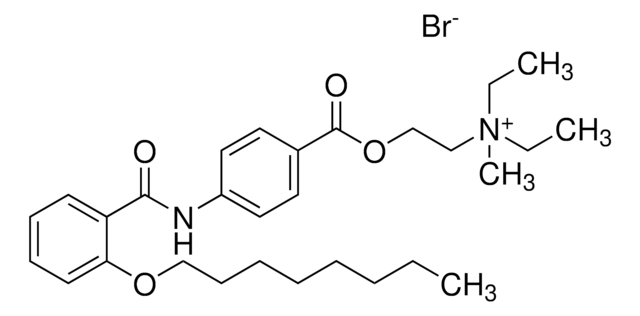08561
(S)-(−)-α -Lipoic acid
≥97% (HPLC)
Sinonimo/i:
(S)-1,2-Dithiolane-3-pentanoic acid, (S)-6,8-Thioctic acid
Autenticatiper visualizzare i prezzi riservati alla tua organizzazione & contrattuali
About This Item
Formula empirica (notazione di Hill):
C8H14O2S2
Numero CAS:
Peso molecolare:
206.33
Beilstein:
81852
Numero MDL:
Codice UNSPSC:
12352106
ID PubChem:
NACRES:
NA.25
Prodotti consigliati
Livello qualitativo
Saggio
≥97% (HPLC)
Purezza ottica
enantiomeric excess: ≥98.0% (HPLC)
Temperatura di conservazione
−20°C
Stringa SMILE
OC(=O)CCCC[C@H]1CCSS1
InChI
1S/C8H14O2S2/c9-8(10)4-2-1-3-7-5-6-11-12-7/h7H,1-6H2,(H,9,10)/t7-/m0/s1
AGBQKNBQESQNJD-ZETCQYMHSA-N
Azioni biochim/fisiol
Biological antioxidant with prooxidant activities . Method for enantioseparation of lipoic acid in dietary supplements by capillary electrophoresis.
Confezionamento
Bottomless glass bottle. Contents are inside inserted fused cone.
Scegli una delle versioni più recenti:
Certificati d'analisi (COA)
Lot/Batch Number
Non trovi la versione di tuo interesse?
Se hai bisogno di una versione specifica, puoi cercare il certificato tramite il numero di lotto.
Possiedi già questo prodotto?
I documenti relativi ai prodotti acquistati recentemente sono disponibili nell’Archivio dei documenti.
I clienti hanno visto anche
Shuji Kodama et al.
Electrophoresis, 33(15), 2441-2445 (2012-08-14)
Lipoic acid, an antioxidant, naturally occurs as the (R)-enantiomer, while synthetic lipoic acid is racemic. It is thus of interest to know the (R)-enantiomer content of lipoic acid supplements. Here, we used capillary electrophoresis to directly enantioseparate lipoic acid in
L Packer et al.
Free radical biology & medicine, 19(2), 227-250 (1995-08-01)
alpha-Lipoic acid, which plays an essential role in mitochondrial dehydrogenase reactions, has recently gained considerable attention as an antioxidant. Lipoate, or its reduced form, dihydrolipoate, reacts with reactive oxygen species such as superoxide radicals, hydroxyl radicals, hypochlorous acid, peroxyl radicals
Hadi Moini et al.
Toxicology and applied pharmacology, 182(1), 84-90 (2002-07-20)
Reactive oxygen (ROS) and nitrogen oxide (RNOS) species are produced as by-products of oxidative metabolism. A major function for ROS and RNOS is immunological host defense. Recent evidence indicate that ROS and RNOS may also function as signaling molecules. However
Ronald Bentley
Chemical Society reviews, 34(7), 609-624 (2005-06-21)
Chiral structures profoundly influence chemical and biological processes. While chiral carbon biomolecules have received much attention, chirality is also possible in certain sulfur compounds; just as with carbon, there can be differences in the physiological behavior of chiral sulfur compounds.
Il team dei nostri ricercatori vanta grande esperienza in tutte le aree della ricerca quali Life Science, scienza dei materiali, sintesi chimica, cromatografia, discipline analitiche, ecc..
Contatta l'Assistenza Tecnica.






